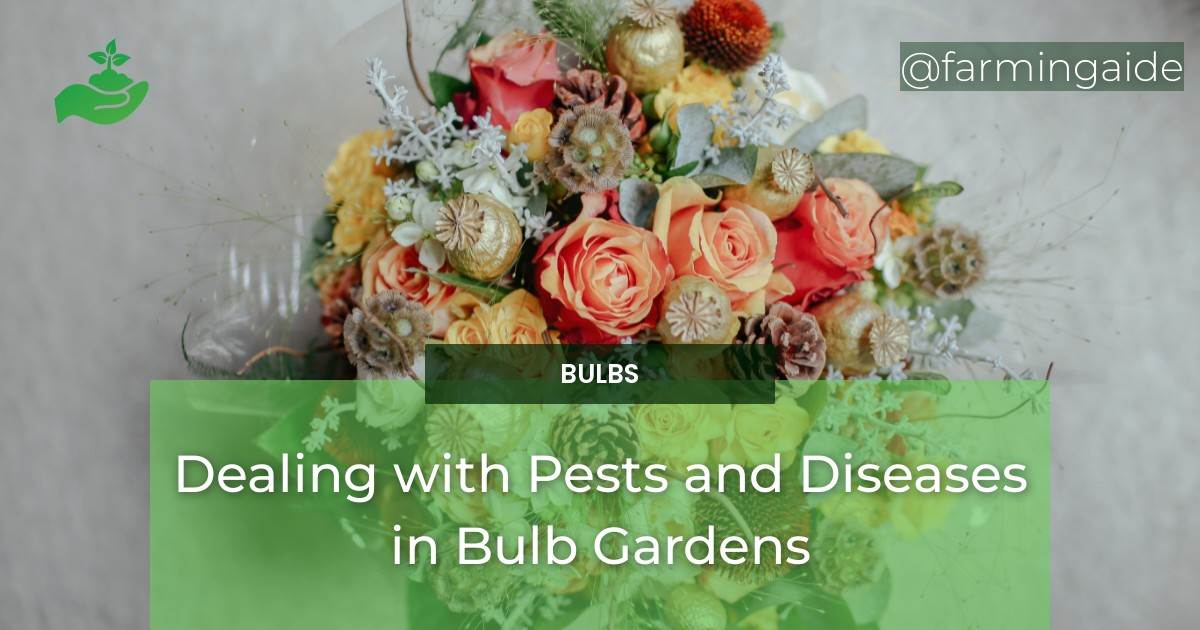Bulb gardens are a popular choice for many gardeners because of the beautiful flowers they produce. These gardens are easy to maintain, and bulbs are relatively resistant to pests and diseases. However, there are times when pests and diseases can strike, causing significant damage to the bulbs and the garden as a whole. Knowing how to deal with these issues is essential for any gardener who wants to keep their bulb garden in top shape.
Dealing with Pests and Diseases in Bulb Gardens
Common Pests Affecting Bulbs and How to Control Them
Bulb pests are a common problem that can cause significant damage to your garden. Here are some of the most common pests that affect bulbs and how to control them:
Aphids
Aphids are small, sap-sucking insects that can quickly multiply and infest your garden. They cause stunted growth and distorted leaves. To control aphids, use insecticidal soap or neem oil. You can also introduce ladybugs into your garden as they are natural predators of aphids.
Thrips
Thrips are tiny, slender insects that feed on leaves, flowers, and shoots. They cause leaves to turn brown and die. To control thrips, use insecticidal soap or neem oil. You can also spray your plants with water to knock them off.
Spider Mites
Spider mites are not true insects but are arachnids. They feed on the underside of leaves, causing them to turn yellow and fall off. To control spider mites, use insecticidal soap or neem oil. You can also spray your plants with water to knock them off.
Slugs and Snails
Slugs and snails are common pests that feed on the leaves and flowers of plants. They leave behind a slimy trail and can cause significant damage. To control slugs and snails, use slug bait or copper tape around the base of your plants.
Narcissus Bulb Fly Larvae
Narcissus bulb fly larvae are the larvae of a small fly that lays its eggs on the surface of the soil. When the eggs hatch, the larvae burrow into the bulbs, causing significant damage. To control narcissus bulb fly larvae, use nematodes or insecticides.
Root Weevils
Root weevils are beetles that feed on the roots of plants, causing them to wilt and die. To control root weevils, use beneficial nematodes or insecticides.
Onion Maggots
Onion maggots are the larvae of a small fly that lays its eggs on the surface of the soil. When the eggs hatch, the larvae burrow into the bulbs, causing significant damage. To control onion maggots, use beneficial nematodes or insecticides.
Common Diseases Affecting Bulbs and How to Control Them
Diseases can also affect bulb gardens, causing significant damage to your plants. Here are some of the most common diseases affecting bulbs and how to control them:
Botrytis Blight
Botrytis blight is a fungal disease that can affect bulbs and flowers. It causes brown spots on leaves and petals. To control botrytis blight, remove infected plant parts and use a fungicide.
Fusarium Basal Rot
Fusarium basal rot is a fungal disease that causes bulbs to rot from the bottom up. It causes the leaves to wilt and turn yellow. To control fusarium basal rot, remove infected plant parts and use a fungicide.
Bulb Mosaic Virus
Bulb mosaic virus is a viral disease that can cause significant damage to bulbs. It causes yellow streaks and mottling on leaves. To control bulb mosaic virus, remove infected plant parts and destroy them. There is no cure for this disease.
Gray Mold
Gray mold is a fungal disease that can affect bulbs and flowers. It causes grayish-brown spots on leaves and petals. To control gray mold, remove infected plant parts and use a fungicide.
Iris Scorch
Iris scorch is a bacterial disease that affects iris bulbs. It causes yellow streaks on leaves and flowers. To control iris scorch, remove infected plant parts and use a bactericide.
Smut
Smut is a fungal disease that can affect bulbs and flowers. It causes black, powdery spots on leaves and flowers. To control smut, remove infected plant parts and use a fungicide.
Soft Rot
Soft rot is a bacterial disease that can affect bulbs. It causes the bulbs to become soft and mushy. To control soft rot, remove infected plant parts and use a bactericide.
Preventing Pests and Diseases in Bulb Gardens
The best way to deal with pests and diseases in bulb gardens is to prevent them from occurring in the first place. Here are some tips to help you prevent pests and diseases:
Proper Hygiene Practices
- Clean your gardening tools and equipment regularly.
- Dispose of infected plant parts properly.
- Wash your hands before and after working in your garden.
Soil Preparation Techniques
- Use well-draining soil to prevent waterlogging.
- Amend your soil with organic matter to improve soil health.
- Avoid overcrowding your plants to improve air circulation.
Companion Planting
- Plant pest-resistant plants near your bulbs.
- Plant herbs and flowers that attract beneficial insects.
- Plant flowers that repel pests.
Use of Horticultural Oil and Pesticides
- Use horticultural oil to control pests.
- Use insecticides and fungicides when necessary.
- Follow the instructions on the label carefully.
Proper Storage of Bulbs
- Store your bulbs in a cool, dry place.
- Inspect your bulbs regularly for signs of pests and diseases.
- Discard any infected bulbs immediately.
Maintaining Optimal Growing Conditions
- Water your bulbs regularly.
- Provide adequate sunlight for your plants.
- Fertilize your bulbs regularly.
By following these tips, you can prevent pests and diseases from causing significant damage to your bulb garden. Remember to inspect your plants regularly and take action at the first sign of a problem.


